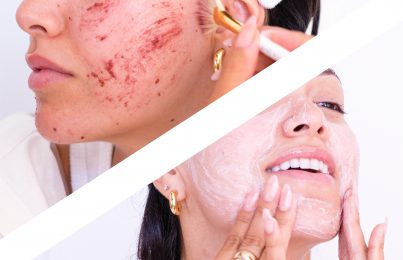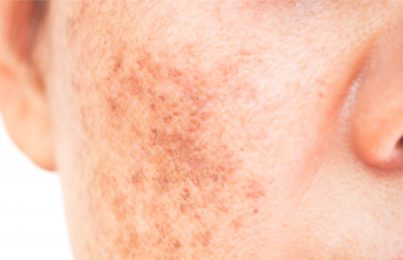Updated 05/15/22. So you just got a chemical peel. An esthetician or dermatologist applied an acid solution to your face to remove the top layers of skin along with any discolored cells. Eventually, the top layers will peel and flake away, revealing brighter, fresher, more youthful-looking skin underneath. Until then, though, you’re left with dryness, irritation, redness, and peeling, which are all perfectly common post-peel side effects. What can you do to manage these side effects and support your skin when it’s in this vulnerable state? Keep reading to learn how to care for your skin after a chemical peel!
Note: The suggestions I share in this post are for light to medium peels. These are the types of peels I perform and they’re the ones with which I have the most experience. The skincare professional who performed your peel should have given you detailed aftercare instructions. If not, you might want to consider contacting them since every peel (and skin type) is different.
How to Care for Your Skin After a Chemical Peel
Be Gentle With Your Skin
It’s so important to be very, very gentle when touching your skin after a chemical peel. Don’t use too much pressure when applying products and avoid any type of aggressive rubbing action. Some of the flaking cells will still be attached to live cells, and you don’t want to risk pulling those off when they’re not ready!
Be Extra Gentle When Your Skin Is Wet
Water melts and softens dead skin, so it’s very easy to rub off both dead and live cells when the skin is moist. Use an especially light touch when your skin is damp from cleansing or showering. And don’t use any type of washcloth or cleansing brush; it’s way too risky (but more on that in a minute).
Wear Sunscreen
This may be stating the obvious, but your skin is extremely vulnerable after a chemical peel. UV light, even if it’s a cloudy day outside, is damaging your skin. Make sure you’re protecting it with a good sunscreen formula. If your skin is super flaky, and you don’t want to touch it or rub it at all, consider using an SPF-infused powder. You can dust it on quickly and easily.
Limit Time Spent Outdoors
After a chemical peel, you want to hibernate as much as possible to keep your skin protected. Avoid exposing your skin to heat and UV light. It’s already in such an inflamed state, and you don’t want to make it worse.
Use Products With Soothing Ingredients
Provide as much comfort to your skin as possible to ease redness and irritation. I tell my clients to use a water-based gel mask (no more than once a day) if they feel like their skin is too uncomfortable. I suggest keeping it in the refrigerator to provide an extra cooling experience. I’ll either recommend the Bio Calm Repair Masque or the Rapid Response Detox Masque, depending on the client’s skin type. I will also have the client use a soothing moisturizer like the Phytolipid Comfort Creme.
Keep Your Skincare Routine Simple
If you’re wondering what to put on your face after a chemical peel, I recommend following this simple routine.
- Use a gentle, sulfate-free cleanser. The Renée Rouleau Moisture Protecting Cleanser is a great gel-to-milk formula that won’t leave the skin feeling dry.
- Mist an essence onto the skin. This is essentially the same thing as an alcohol-free toner, but it’s serum-infused for extra moisture. Normally, you’d apply it on a toning cloth and wipe it over the skin. To minimize rubbing and touching, though, you’ll want to put it in a spray bottle and mist it onto the skin. If you don’t have a spray bottle, pour it into the palm of your hand and gently pat it on the face. I recommend the Renée Rouleau Moisture Infusion Toner for this step. It deeply hydrates the skin and can be used year-round for skin types that need it.
- Apply a gentle vitamin C serum. After a chemical peel, free radical production is high. You’ll want to suppress some of that free radical activity with a gentle vitamin C serum. Plus, chemical peels can stimulate melanin activity and cause hyperpigmentation. A well-formulated vitamin C serum can help calm melanin cells. What you should know, though, is that many vitamin C serums use acid-based ingredients. You’ll want to avoid these and use serums with ingredients like Magnesium Ascorbyl Phosphate, Tetrahexyldecyl Ascorbate, Ascorbyl Methylsilanol Pectinate, or Ascorbyl Palmitate, instead. These are considered best for sensitive skin since they are stable, acid-free, and don’t cause a stinging sensation.
- Apply moisturizer. During the day, use a moisturizer with sunscreen. One with Zinc Oxide is ideal, as it will be more soothing to the skin. In the evening, use a non-sunscreen moisturizer that’s formulated for your skin type.
What Not to Do After a Chemical Peel
Don’t Pick or Pull at Your Skin
The whole purpose of a chemical peel is to lift away dry, damaged cells and reveal younger-looking cells underneath. But to do this, the skin has to shed. That’s the part that people dislike the most. It’s worth the wait, though. If you pick off dry, flaky skin that’s not ready to come off, it could cause scarring and unnecessary redness. It’s best to leave it alone!
Don’t Use a Washcloth, Facial Scrub, or Sonic Cleansing Brush
As mentioned above, dead, flaky skin softens when exposed to water. It can be very tempting to want to rub away that dryness with a washcloth, facial scrub, or sonic cleansing brush. Please don’t use any of these. Should any new cells come along with it (which they will!), you’ll wind up with scabs all over your face. I’ve seen it happen time and time again. This certainly defeats any benefits of getting the peel in the first place.
Don’t Use any Acid Ingredients
Just like how you shouldn’t use any physical exfoliants (washcloths, scrubs, or brushes), you should use any chemical exfoliants (acids and enzymes). You must let the skin shed naturally on its schedule. Acids and enzymes, whether in a cleanser, toner, serum, mask, or moisturizer, will only irritate the skin further and possibly burn and temporarily scar the skin.
Don’t Over-Moisturize
When the skin is peeling and flaky, it’s normal to want to continually apply face oil or heavy moisturizer to alleviate dryness. While it’s important to keep the skin moisturized, you don’t want to moisturize too much. After all, the whole purpose of a chemical peel is to PEEL. And the less rubbing, massaging, and tugging on the skin you do, the better.
Use a comforting moisturizer twice a day and let the skin do what it wants to do—shed. If you are going out and want to camouflage some of the flakiness, pat a few drops of face oil on the skin, like the Renée Rouealu Pro Remedy Oil.
Don’t Eat Highly Acidic Foods
When acidic foods like tomato sauce, oranges, and salsa touch the face, they can lower the pH of the skin and cause irritation. (Believe it or not, I’ve seen a lot of people get burns/rashes on the sides of their mouths after a chemical peel from eating pizza!)
When you get a chemical peel, your moisture barrier is very damaged and your skin acts extremely sensitive. Since the mouth area is the place where you’ll see the most peeling due to facial movements from talking and yawning, this area can be very reactive. It’s best to put a pause on eating acidic foods until your skin feels better.
Don’t Sweat Too Much
Especially at the height of peeling, your moisture barrier is very damaged. When you sweat while working out, the salt in your sweat can cause a stinging sensation which may further irritate your skin. I suggest doing low-impact workouts to minimize sweating during this time.
Don’t Use Retinol or Prescription Retinoids
These products stimulate cell turnover from deep within the skin. While this is normally great for the skin, it’s already happening after a chemical peel, and you don’t want to kick your skin into overdrive and cause more irritation. Just like with exfoliating acids, you’ll want to use these once your skin feels better, just not quite yet!
So there you have it. These are my best tips after over 30 years of experience giving and getting chemical peels!
Next, learn how you can give yourself a chemical peel at home.
Celebrity Esthetician & Skincare Expert
As an esthetician trained in cosmetic chemistry, Renée Rouleau has spent 30 years researching skin, educating her audience, and building an award-winning line of products. Her hands-on experience as an esthetician and trusted skin care expert has created a real-world solution — products that are formulated for nine different types of skin so your face will get exactly what it needs to look and feel its best. Trusted by celebrities, editors, bloggers, and skincare obsessives around the globe, her vast real-world knowledge and constant research are why Marie Claire calls her “the most passionate skin practitioner we know.”




Comments:
I just finishing up my chemical peel 2 weeks ago
my skin is looking normal now
Is that ok for me to start to put avocado mask on every night?
And what kind of brightness serum that I need to ?
Posted By: Anna Mandy Truong |
I never recommend to my clients to put avocado on their skin, especially when their skin has just been freshly peeled. As for a serum that is good for brightening, a vitamin C serum is your best bet for this.
Posted By: Renée Rouleau |
I have done my 3rd chemical peel couple of days before. after 2nd peel my face was clear and acne free. but after this 3rd peel i have lot of white heads and they become redness. also itchy bit. why this happen? do i need get treatments. is it suitable for get another peel during this month.
Posted By: Ash |
It’s hard for me to comment without knowing any details about your skin and the peels that were used. Perhaps your skin is being over-peeled and it’s causing a lot of inflammation. You are best to talk with your doctor about all of this, as well as why he or she suggested you use that gel.
Posted By: Renée Rouleau |
Hi.
I had a glycolic peel few days ago but my dermatologist has not given me proper instructions about post peel. He has prescribed a brightening cream. Is that enough??
Posted By: Divyansh ujjwal |
Other than the tips I’ve provided, I can’t give any guidance as I don’t know what was done to your skin or any details. I suggest you contact your derm and ask them how it’s best to care for your skin type after a peel.
Posted By: Renée Rouleau |
Hey. I just got a chemical peel done for my acne. This was my first time. My doctor told me to not wash my face with anything but water for three days.
My skin is oily, can I not even wash it for once with a facewash ?
Posted By: Aayushi |
I’m not sure why they would suggest this so it’s best to ask for the reason behind it.
Posted By: Renée Rouleau |
I’m confused. Most of my dermatologists say to hydrate a minimum of twice daily to help the healing process post peel and helps to regenerate skin faster. Even recommend heavy creams (Vaseline even, or aquaphor) for the first couple of days (not too long otherwise it’ll clog pores).
Posted By: Roberta troy |
Some heavy duty peels such as a TCA peel, it is recommended to keep the skin moist but not all peels are equal so you always want to go with the recommendation of your skin care professional.
Posted By: Renée Rouleau |
I had a mild checmichal peel (sal/gly 10%), a couple of days ago. This morning while washing my face a used a facial sponge (soft). While washing my face I noticed some of he dry flaking skin rubbed off. Now my face is red and tender/sensative. Do have suggestions on what I should use to calm the irritation? Thank you
Posted By: Sara |
Hi Sara, When your skin is wet, the cells get really moist and easy to rub off so I can understand why your skin is irritated and probably feeling kind of raw. At this point, it’s best to leave it alone because the more you put on it, the more things will sting and the skin will stay moist. You want everything to dry out so that things can heal up. Don’t over-moisturizer, but a light lotion will keep it feeling comfortable when you talk and make facial expressions. Contact the person who did the peel if you need more assistance.
Posted By: Renée Rouleau |
I have uneven face skintone with dark spots on 20% area of face. I ‘m planning to go for chemical peeling treatment (light or medium) from any dermatologist, please tell me how much days I would have to avoid sunlight after this treatment? And other precautions required?
Posted By: Shaminder Gill |
You for sure will want to get this information from the person who is administering the peels because there are so many different types and all have different side effects. However, in general, you would want to limit outdoor activities for 5-7 days, and of course, wear sunscreen even when indoors as daylight can come through windows. You can read more information about chemical peels here.
Posted By: Renée Rouleau |
After the peeling has completely stopped, is that when I go back to my normal facial routine?
Posted By: Sue Cook |
Generally yes, but your skin care professional should give you instructions of when exactly to get back to your normal routine. Exfoliating products are the ones that you want to wait a bit before using.
Posted By: Renée Rouleau |
Hi,
After four day of Chemical Peel treatment ,there are some new dark patches on my face ,consulting with my doctor since last two week and using the moisturize and creams but not help very much so please advise what to do now , feeling very embarrassing
Posted By: Rekha |
Using a gentle, no-sting vitamin C serum like Vitamin C&E Treatment is excellent for putting active melanin cells asleep that have been inflamed from a chemical peel.
Posted By: Renée Rouleau |
could you please tell me if i can do yougart mask after 5 days of chemical peel
Posted By: Gulshah |
That would be a question for the person who did your peel. Every peel has a different strength and every skin responds differently to yogurt…or any other product post-peel.
Posted By: Renée Rouleau |